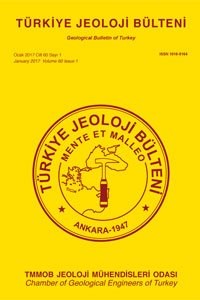Öz
The Çamlıca metamorphic association located on the western part of the Biga Peninsula covers an area of 2 about 196 km . The rock units of the Çamlıca metamorphic association are separated into three units, which are described as formations based on the partly determined internal structure, on contact relationships, and on a mappable unit. These formations from bottom to top are, respectively: the Andıktaşı formation which comprises metalava, metatuff, and metapelite and that appears brown, green, and yellowish green-coloured in the field; the Dedetepe formation which is mainly made up of quartz-muscovite schist, garnet-muscovite schist, garnet-albitechlorite schist and albite-chlorite-epidote schist, black marble, calc-schist, amphibolite and eclogite. On the top, the Salihler formation is composed mainly of phyllite, calc schist and white marble intercalations. The Denizgören ophiolite, including serpentinised peridotite, tectonically overlies the Çamlıca metamorphic association. Petrographical investigations, using index minerals of albite - garnet - epidote - chlorite observed in three different formations, indicate that the Çamlıca metamorphic association was subjected to the greenschist - facies metamorphism. An early eclogite - facies mineral assemblage of garnet + omphacite + glaucophane + amphibole has been determined. These mineral associations were subjected to amphibolite-facies metamorphism and finally to retrograded greenschist-facies metamorphism. The Çamlıca metamorphic association is, then, probably an equivalent of the Iznik metamorphics located in the Sakarya Zone in terms of lithostratigraphy, stratigraphy and metamorphic characteristics.
Anahtar Kelimeler
Biga Peninsula eclogite regional metamorphism the Iznik metamorphics
Kaynakça
- Aldanmaz, E. et. al. PDF dosyada kaynakçaya bakınız.
Öz
Biga Yarımadası'nın batı kesiminde yeralan Çamlıca metamorfik topluluğu yaklaşık olarak 196 km lik bir alanı kaplamaktadır. Bu topluluğu oluşturan kaya birimleri kendi içerisinde ilk kez bu çalışmada kısmen tanınabilen iç yapısı, alt-üst ilişkisi ve haritalanabilir olması nedeniyle formasyon aşamasında tanıtılmış ve bu formasyonlar alttan üste doğru sırasıyla; metalav, metatüf ve metapelitten oluşan ve arazide kahverengi, yeşil, sarımsı yeşil renkte gözlenen Andıktaşı formasyonu; muskovit-kuvars şist, granat-mika şist, albit-epidot-klorit şist, kalkşist, siyah mermer, amfibolit ve eklojitten oluşan Dedetepe formasyonu ve en üstte ise fillit, mermer ve kalkşist ardalanmasından oluşan Salihler formasyonundan oluşmaktadır. Büyük bölümü serpantinleşmiş peridotitlerden oluşan Denizgören ofiyoliti tektonik olarak Çamlıca metamorfik topluluğunun üzerinde yeralmaktadır. Petrografik çalışmalar sonucunda üç formasyonda gözlenen albit-epidot-granat-klorit parajenezi Çamlıca metamorfik topluluğunun yeşilşist fasiyesinde metamorfizmayı temsil etmektedir. Eklojitlerde yüksek basınç metamorfizmasını gösteren yaygın granat + omfasit + glokofan + zoisit + amfibol ± sfen mineral topluluğu saptanmıştır. Bu mineral topluluğu daha sonra gelişen amfibolit fasiyesinde ve en son olarak yeşilşist fasiyesinde retrograd bir metamorfizmaya uğramıştır. Çamlıca metamorfik topluluğu litolojik ve stratigrafik nitelikleri ile metamorfizma özellikleri bakımından Sakarya Zonu içerisinde yüzlek veren İznik metamorfik topluluğunun eşleniği olabilecek özellikler içermektedir.
Anahtar Kelimeler
Biga Yarımadası eklojit bölgesel metamorfizma İznik metamorfikleri
Kaynakça
- Aldanmaz, E. et. al. PDF dosyada kaynakçaya bakınız.
Ayrıntılar
| Birincil Dil | Türkçe |
|---|---|
| Konular | Yer Bilimleri ve Jeoloji Mühendisliği (Diğer) |
| Bölüm | Makaleler - Articles |
| Yazarlar | |
| Yayımlanma Tarihi | 1 Nisan 2007 |
| Gönderilme Tarihi | 29 Mart 2017 |
| Yayımlandığı Sayı | Yıl 2007 Cilt: 50 Sayı: 1 |
Kaynak Göster
Yazım Kuralları / Instructions for Authors /https://dergipark.org.tr/tr/pub/tjb/writing-rules / https://dergipark.org.tr/en/pub/tjb/writing-rules
Etik lkeler ve Yayın Politikası / Ethical Principles and Publication Policy / https://dergipark.org.tr/tr/pub/tjb/policy / https://dergipark.org.tr/en/pub/tjb/policy

